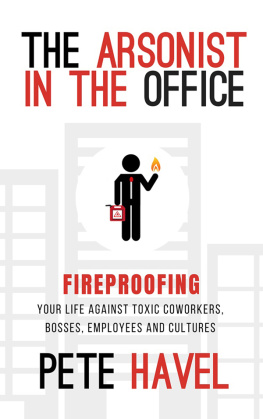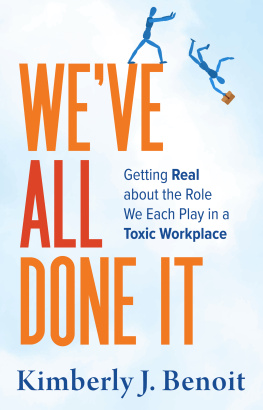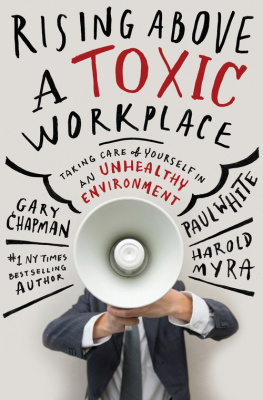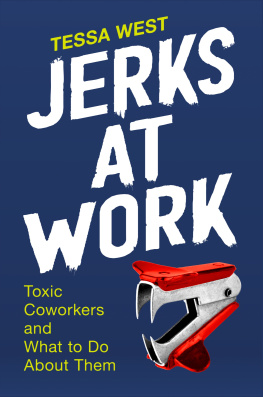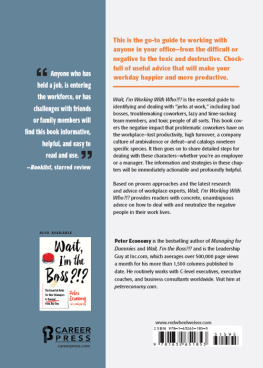For all of my hundreds of friends in the nonprofit world, this chapters for you. Much like people who live charmed lives and always work in great environments, this wont affect everyone, but it will hit a lot of you at some point. That is, what do you do when dealing with a toxic membership-based organization? Its a difficult problem to navigate for staff members, but that also holds true for volunteers within the organization. I have some thoughtssome strong ones at that. When membership or volunteer organizations become toxic, they have the potential to become extremely toxic. And a quick fix is nearly impossible.
As I mentioned previously, I have spent a significant part of my life working inside membership organizations: Chambers of commerce and trade associations, mostly, but I have also been involved in my church, school groups, and as a volunteer for other charitable organizations. And let me tell you, arsonists are everywhere.
Volunteer organizations are the lifeblood of many communities. Chambers tie the business community together. Trade associations provide a sense of unity and focus for many businesses. Houses of worship join us together around our common faith. And school groups and charitable organizations bring us together around what motivates or inspires us to help solve a problem or better our community.
Toxic companies have been studied for years. If you pick up a copy of Forbes or Inc ., there is an excellent chance you will see a reference to some sort of corporate study, poll, or white paper on something involving culture within the business community. Some of those are referenced in this book.
More recently, numerous articles have focused on the military and its issues with toxicity. These organizations retain their employees in different ways.
Businesses offer salary, bonuses, and essential benefits like healthcare and retirement plans. These are all handcuffs that attach employers to employees in ways that encourage long-term commitments, even if toxicity exists. If toxicity exists, an employee can ask for a transfer to another department or look for another job. They can vote with their feet, so to speak.
The military offers salary, exceptional benefits, and a clear and noble purpose, the combination of which handcuffs service members to military service for years. Of course, it also retains employees through literal handcuffs if someone attempts to leave before their scheduled timeits called court martial for desertion! And thats a pretty strong incentive to stick around! That doesnt necessarily solve the toxicity problem, but it definitely compartmentalizes it for the time someone serves.
As someone who has worked in non-profit volunteer organizations both as an employee (trade associations and chambers of commerce) and volunteer (churches and school organizations), I have thought a lot about what happens if your volunteer organization becomes toxic. Your organization matters to your members and volunteers, but not if theyre feeling disenchanted, disenfranchised, or disgusted by the way people act at the top. The paychecks arent keeping them there. There is no jail sentence for desertion. People can simply leave, along with their many contributions, and there is nothing to stop them. The situationwhether blatantly or subtlycan harm an organization for a long time.
What do you do?
There are three elements to consider within a volunteer organization: paid staff, rank-and-file volunteers whose involvement is less frequent and more targeted, and volunteer leadership, like members of a board of directors or committee chairs.
As for staff in a volunteer organization, if theyre either the cause of the toxicity or the ones being affected by the problems, there are some tough but simple choices to consider. If a staff member is causing the toxicity, they can be terminated. If the staffer is feeling the toxicity, they can either work to help change the culture, or they can make a personal decision to leave the organization.
The rank-and-file members can affect the culture in some ways, but if theyre not in leadership, they normally dont have significant power and likely do not participate as actively. Rank and file can have problem volunteers, but theyll be more the exception than the rule.
But what if neither the staff nor the rank and file is the problem?
What if the problem is at the core of the organizationthe volunteer leadership or the lingering culture? The people setting the rules, being the faces of the organization, the ones modeling behavior that demonstrates what it means to be a member? What if the answer of This is how weve always done it prompts the organization to do culturally poisonous things? What if the culture has gone so far astray, all that is left is people who dont even know what a healthy organization looks like or you have board members in place who are happy to fill a chair, slap the board member title on a resume, and accept a free meal?
If your leadershipwhether its all of your leaders or just the most vocal onesis toxic, you have problems you need to fixand soonbefore things get worse.
Why? Its pretty simple. Unlike employers who can negotiate with money and benefits or the military who have carrots and sticks for staying in the service, volunteer organizations offer little to tie people to their group if what the member is receiving is simply a miserable experience. Volunteers can cut off the check writing or find something better to do with their time.
Its the easiest of situations to leave: nothing is forcing someone to volunteer their time, and many people will not volunteer to be treated disrespectfully or willingly be part of something that excludes them.
There are plenty of signs to look for when considering if your organization or your leadership is toxic. If you ask many nonprofit professionals, theyll tell you that if a volunteer organizations board is toxic, the full organization likely is, as well.
What are the things to look for when considering if your volunteer organizations leadership is toxic?
- Are secret meetings commonplace? Information inside board meetings should always be confidential, but elements of the board should not be holding out on providing information to other board members. Toxic secrecy may manifest itself as board members holding secret or unofficial meetings as a group or major members of the board holding meetings on the side with a few key board allies. An executive board withholding key information from the general board can also have a debilitating effect on the discourse and trust level within an organization. When the general board does not trust the executive committee, you have the first of many problems that will emerge.
- Does information leak out? Its problematic if discussion of whats happening inside the organization is leaked shortly after the board meetings end. When this happens, board members are disrespecting their own code of conduct as board members. Leaking can be a problem in and of itself depending upon the information leaked, but it is also a major red flag.
- Are you hostage to a hostile environment? When board members do not get along, it can create a chilling effect on the ability of the board to act or respond to challenges. Do you have members resign due to run-ins with toxic leadership?
- What about personal agendas? When board members are voting based on their own personal or political agendas, it can poison the well for ethical decision-making by all members. It lowers the standards and creates the potential of But everyone else does it... becomes an unofficial policy within the bylaws. They may also be attempting to influence on behalf of their spouse, child, or close friend.
- Are low ethical standards an issue? Those implementing the decisions of the board (the staff) must be able to trust the board. Are the decision-makers around the board room ethical people? If the answer is no, the problems will follow.

